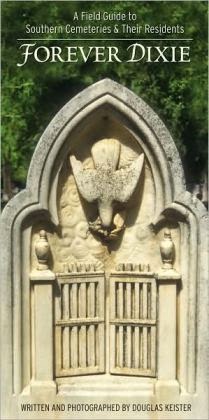Southern History Department's Book of the Month: Forever Dixie: A Field Guide to Southern Cemeteries & Their Residents
Forever Dixie: A Field Guide to Southern Cemeteries & Their Residents
Douglas Keister
One evening a few years ago, I was on the way to visit some friends. As I drove along the winding county road to their home, I caught sight of something I had never known was there before: a small cemetery. I braked to take a closer look and wondered why I had never noticed it, but I drew the line at getting out and walking over to examine the old grave markers; dusk was gathering and I remember thinking that this is how horror movies begin.
If you’re the sort of person who would have gotten out of the car and gone running to have a look at the tombstones, you’ll want to get your hands on Forever Dixie: A Field Guide to Southern Cemeteries & Their Residents. This is a book to warm the hearts of genealogists, cemetery preservation societies, and anyone else who is just plain fascinated with the history and lore of cemeteries. Keister treats us to an in-depth look at several quintessentially Southern cemeteries, and for his definition of Southern he explains that “for the purpose of this book, we’ve placed the center of Dixie in northwestern Alabama and drawn a very wavy line around it. We’ve only included states where almost all of the state has a Southern feel.”
Not all of the cemeteries under discussion are for human interment. One of Keister’s picks is the famous Key Underwood Coon Dog Memorial Graveyard near Tuscumbia, Alabama, where “to qualify for burial, the dog’s owner must claim their dog is an authentic coon dog, a witness must verify that information, and a member of the Coon Hunters Association must be allowed to view the expired coonhound.” Talk about exclusive.
Keister also provides GPS coordinates for each cemetery so readers can go directly to markers of special interest and includes some fascinating information and photographs of funerary architecture and symbols. Have you ever seen a mort safe? How about a table tomb? Or a treestone? What does it signify if a gravestone is carved with daisies? Wheat? Ivy?
Forever Dixie was an unexpectedly entertaining read for me, and for anyone who already has a fascination with cemeteries, it is a must. I think now I’d have more interest in going back to examine that little cemetery along the lonely county road—but I’ll still confine my investigation to daylight hours.
Can’t get enough of cemetery research? For further information:
Find A Grave
Alabama Cemetery Preservation Alliance
Association for Gravestone Studies Facebook Page
Mary Anne Ellis
Southern History Department
Central Library
Douglas Keister
One evening a few years ago, I was on the way to visit some friends. As I drove along the winding county road to their home, I caught sight of something I had never known was there before: a small cemetery. I braked to take a closer look and wondered why I had never noticed it, but I drew the line at getting out and walking over to examine the old grave markers; dusk was gathering and I remember thinking that this is how horror movies begin.
If you’re the sort of person who would have gotten out of the car and gone running to have a look at the tombstones, you’ll want to get your hands on Forever Dixie: A Field Guide to Southern Cemeteries & Their Residents. This is a book to warm the hearts of genealogists, cemetery preservation societies, and anyone else who is just plain fascinated with the history and lore of cemeteries. Keister treats us to an in-depth look at several quintessentially Southern cemeteries, and for his definition of Southern he explains that “for the purpose of this book, we’ve placed the center of Dixie in northwestern Alabama and drawn a very wavy line around it. We’ve only included states where almost all of the state has a Southern feel.”
Not all of the cemeteries under discussion are for human interment. One of Keister’s picks is the famous Key Underwood Coon Dog Memorial Graveyard near Tuscumbia, Alabama, where “to qualify for burial, the dog’s owner must claim their dog is an authentic coon dog, a witness must verify that information, and a member of the Coon Hunters Association must be allowed to view the expired coonhound.” Talk about exclusive.
Keister also provides GPS coordinates for each cemetery so readers can go directly to markers of special interest and includes some fascinating information and photographs of funerary architecture and symbols. Have you ever seen a mort safe? How about a table tomb? Or a treestone? What does it signify if a gravestone is carved with daisies? Wheat? Ivy?
Forever Dixie was an unexpectedly entertaining read for me, and for anyone who already has a fascination with cemeteries, it is a must. I think now I’d have more interest in going back to examine that little cemetery along the lonely county road—but I’ll still confine my investigation to daylight hours.
Can’t get enough of cemetery research? For further information:
Find A Grave
Alabama Cemetery Preservation Alliance
Association for Gravestone Studies Facebook Page
Mary Anne Ellis
Southern History Department
Central Library

Comments